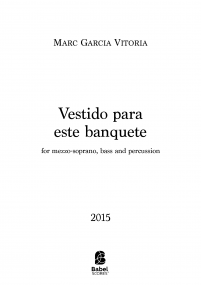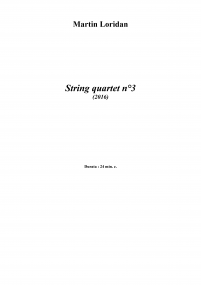Recherche avancée
"(...) una persecución en la sombra"
ISMN : 979-0-2325-3873-0
- Identifiez-vous pour créer une liste
Writing a piece for voice after an existing text is, without a doubt, one of the biggest challenges a composer of contemporary music can accept. The fact that words have meaning radically differentiates music from other arts that deal with the latter. It is precisely due to the abstract nature of music that a space is opened for any composer; a space full of both possibilities and stimulating challenges.
During the process that has been taking place in this laboratory of music and poetry, it is in various levels where music and words have converged: on the one hand, the permanent feeling of insistent calling, somehow uncomfortable and even existential, is present in Guadalupe Grande’s poem as well as in my own composition. “(…) and that cat does not stop meowing and is a small injury you don’t know what kind you don’t know of whom but it is there insisting (…) And the cats keep on giving birth and they give birth to onomatopoeias that at the back of the garden resound as the Law of Moses”.
On the other hand, a much more abstract approach also takes place when facing the creative process: the first meeting between the poet and the rest of the 2018 EPOS Lab Team made us discover that one of Guadalupe’s intentions while writing is the search, the hunting of something fugacious. Her “(…) persecution in the shadow” is a clear critique of the language’s clarity that touches my artistic intention as well. The focus on the abstract and the trust in the intelligence of the audience and the reader, is an intention that we both likewise share.
Another important element in which music and poetry match, is the idea of depth. A depth that is latent in the verses written by Guadalupe in her Cats giving birth: “(…) at the back of the garden (…) at the back in the deepest (…) one summer and another more at the bottom of life at the back of the garden at the bottom of sound”. Accordingly, the scenic dimension plays an important role: the already mentioned insistent calling takes a spatial form through a journey made by the performers to the back of the concert hall. From there, the distant calling of the “non-lyric, unmasked onomatopoeia, as an unspoken sound”, “the meow”, “the helpless sound”… is simulated.
Lastly, I would like to praise the bravery of the whole team in this project as well as the opportunity given to young composers. This Laboratory has constituted a quest during the process of investigation as well as in its final scenic phase. This truly joint instrospectionhas been possible only thanks to the effort and enthusiasm made by each of the involved artists.
Pages - 16








